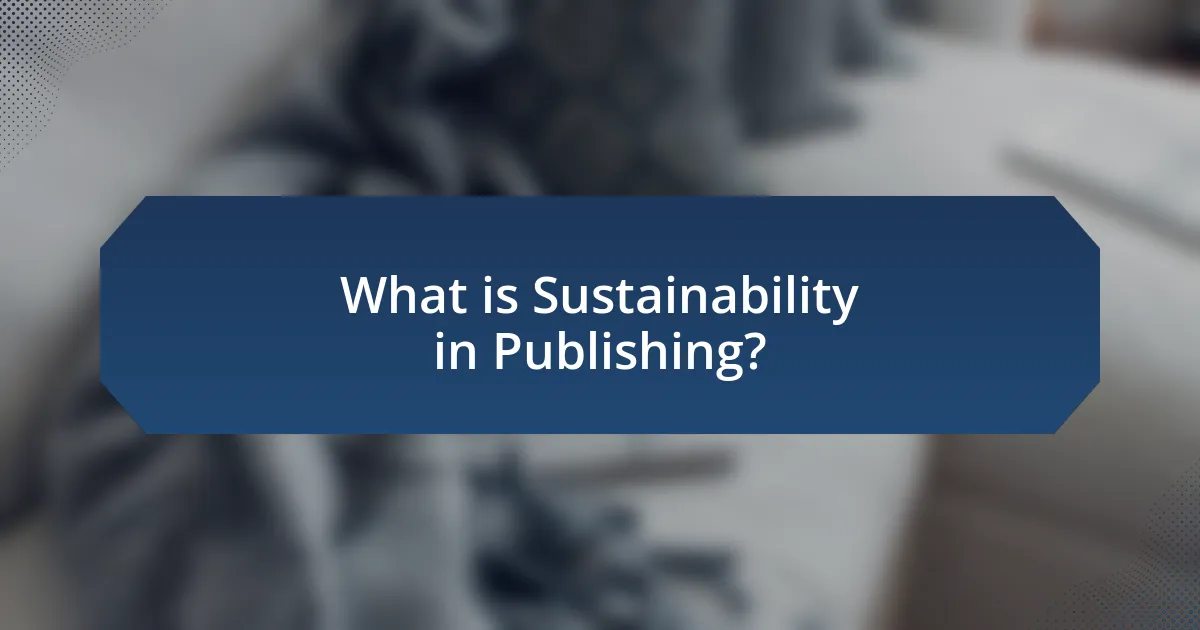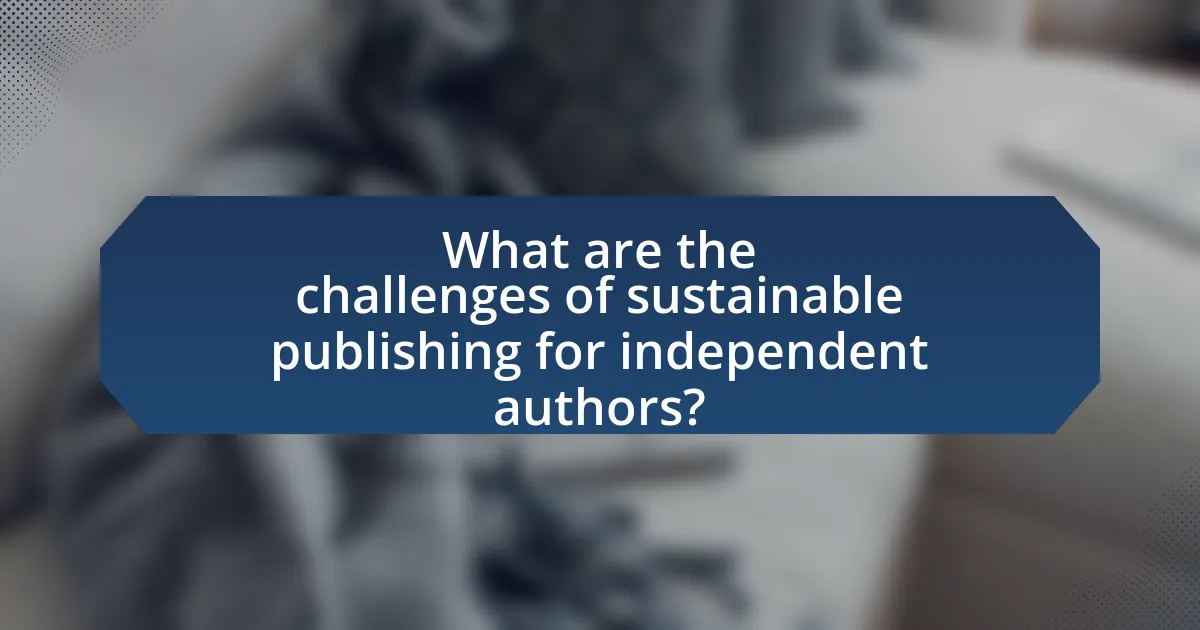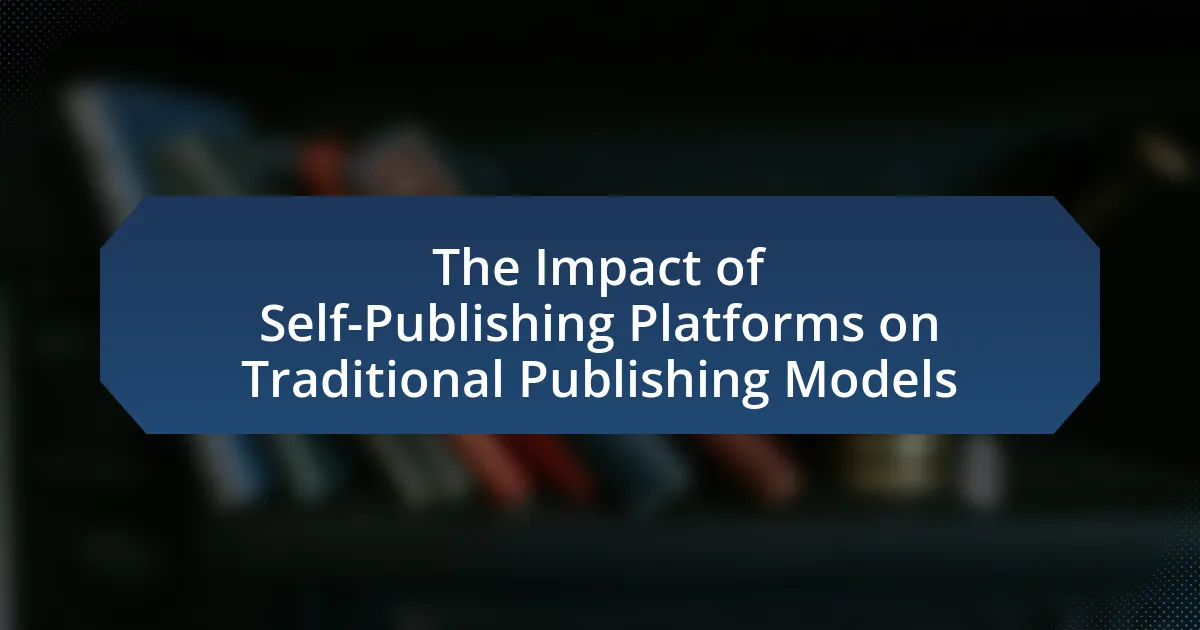Sustainability in publishing involves integrating eco-friendly practices throughout the publishing process to reduce environmental impact. This article explores the importance of sustainability for independent authors, highlighting how adopting eco-friendly materials, digital publishing, and efficient distribution methods can enhance marketability and align with consumer values. It discusses the environmental challenges of traditional publishing, the benefits of sustainable practices, and the obstacles independent authors face in implementing these methods. Additionally, it provides insights into best practices for sustainable publishing and strategies for authors to promote their eco-friendly initiatives effectively.

What is Sustainability in Publishing?
Sustainability in publishing refers to the integration of eco-friendly practices throughout the publishing process to minimize environmental impact. This includes using sustainable materials, such as recycled paper and eco-friendly inks, as well as adopting digital publishing methods to reduce waste. According to a report by the Book Industry Environmental Council, the publishing industry can significantly lower its carbon footprint by implementing these practices, which not only benefit the environment but also appeal to a growing consumer base that values sustainability.
Why is sustainability important for independent authors?
Sustainability is important for independent authors because it enhances their marketability and aligns with consumer values. As readers increasingly prioritize eco-friendly practices, authors who adopt sustainable methods can attract a larger audience. For instance, a 2021 survey by Nielsen found that 73% of global consumers are willing to change their consumption habits to reduce environmental impact. By implementing sustainable practices, such as using recycled materials for print books or opting for digital formats, independent authors can not only reduce their carbon footprint but also resonate with environmentally conscious readers, ultimately leading to increased sales and a positive brand image.
What are the environmental impacts of traditional publishing practices?
Traditional publishing practices have significant environmental impacts, primarily due to deforestation, energy consumption, and waste generation. The production of paper for books contributes to the depletion of forests, with approximately 30% of the world’s harvested timber used for paper products. Additionally, traditional publishing involves high energy usage in printing and distribution processes, leading to increased carbon emissions. Furthermore, the lifecycle of printed books often results in substantial waste, as many books are discarded or not recycled, contributing to landfill overflow. These factors collectively highlight the environmental challenges associated with conventional publishing methods.
How can independent authors contribute to sustainability?
Independent authors can contribute to sustainability by adopting eco-friendly publishing practices, such as using print-on-demand services, which reduce waste by only printing books as they are ordered. This method minimizes excess inventory and paper usage, aligning with sustainable resource management. Additionally, independent authors can choose to publish e-books, which eliminate the need for physical materials and distribution, further decreasing their carbon footprint. Research indicates that digital formats can significantly lower environmental impact compared to traditional print methods, as they require fewer resources and generate less waste. By implementing these practices, independent authors play a crucial role in promoting sustainability within the publishing industry.
What are the key principles of eco-friendly publishing?
The key principles of eco-friendly publishing include the use of sustainable materials, energy-efficient production processes, and responsible waste management. Sustainable materials involve sourcing paper from recycled or responsibly managed forests, which reduces deforestation and environmental impact. Energy-efficient production processes minimize carbon footprints by utilizing renewable energy sources and optimizing machinery for lower energy consumption. Responsible waste management practices, such as recycling and reducing excess materials, further contribute to minimizing environmental harm. These principles collectively aim to create a publishing model that prioritizes ecological health while maintaining quality and accessibility in literature.
What materials can be used to promote sustainability in publishing?
Sustainable publishing can be promoted using materials such as recycled paper, soy-based inks, and biodegradable packaging. Recycled paper reduces the demand for virgin pulp, conserving forests and energy; for instance, using 100% recycled paper can save up to 24,000 gallons of water per ton produced. Soy-based inks are more environmentally friendly than traditional petroleum-based inks, as they emit fewer volatile organic compounds (VOCs) and are easier to de-ink during recycling. Biodegradable packaging, such as compostable mailers, minimizes plastic waste and supports a circular economy. These materials collectively contribute to reducing the environmental impact of publishing activities.
How does digital publishing compare to print in terms of sustainability?
Digital publishing is generally more sustainable than print publishing due to its reduced resource consumption and lower environmental impact. Digital formats eliminate the need for paper, ink, and physical distribution, which significantly decreases deforestation and carbon emissions associated with traditional printing processes. For instance, a study by the University of Cambridge found that e-books can produce up to 80% less carbon dioxide over their lifecycle compared to printed books, primarily due to the absence of materials and transportation requirements. Additionally, digital publishing allows for easier updates and revisions, reducing waste from unsold printed copies.

How can independent authors implement eco-friendly practices?
Independent authors can implement eco-friendly practices by utilizing print-on-demand services and digital publishing options. Print-on-demand minimizes waste by only producing books as they are ordered, reducing excess inventory and paper usage. Digital publishing eliminates the need for physical materials altogether, significantly lowering the carbon footprint associated with traditional printing and shipping. Additionally, authors can choose eco-friendly materials for any physical books, such as recycled paper and soy-based inks, which further supports sustainable practices in the publishing industry.
What are some sustainable printing options available to authors?
Authors have several sustainable printing options available, including print-on-demand services, recycled paper, and eco-friendly inks. Print-on-demand minimizes waste by printing books only when ordered, reducing excess inventory. Using recycled paper helps decrease deforestation and energy consumption, as it requires less processing than virgin paper. Eco-friendly inks, often made from vegetable oils, are less harmful to the environment compared to traditional petroleum-based inks. These practices collectively contribute to a more sustainable publishing process, aligning with the growing demand for environmentally responsible choices in the industry.
What is print-on-demand and how does it support sustainability?
Print-on-demand is a printing technology that allows books and other products to be printed only when an order is placed, eliminating the need for large print runs and inventory storage. This model supports sustainability by significantly reducing waste, as it minimizes overproduction and the associated environmental impact of unsold goods. According to a study by the Environmental Protection Agency, traditional printing methods can lead to substantial paper waste, while print-on-demand practices can decrease this waste by producing only what is needed, thus conserving resources and reducing carbon emissions associated with transportation and storage.
How can authors choose eco-friendly paper and inks?
Authors can choose eco-friendly paper and inks by selecting products that are certified by recognized environmental standards, such as the Forest Stewardship Council (FSC) for paper and soy or vegetable-based inks for printing. Eco-friendly paper is often made from recycled materials or sourced from sustainably managed forests, which reduces deforestation and environmental impact. Additionally, using inks that are free from harmful chemicals and solvents minimizes pollution and health risks. Research indicates that using recycled paper can save up to 60% of energy and reduce greenhouse gas emissions compared to conventional paper production. Therefore, by prioritizing these certifications and materials, authors can significantly contribute to sustainable publishing practices.
What role does distribution play in sustainable publishing?
Distribution plays a crucial role in sustainable publishing by ensuring that eco-friendly materials and practices reach a wider audience efficiently. Effective distribution channels can minimize carbon footprints through optimized logistics, such as using local suppliers and digital formats, which reduce the need for physical transportation. For instance, the use of print-on-demand services allows for reduced waste, as books are only produced when ordered, aligning with sustainable practices. Furthermore, research indicates that digital distribution can significantly lower environmental impact, as e-books eliminate paper use and shipping emissions. Thus, strategic distribution not only enhances accessibility but also supports the overall sustainability goals of the publishing industry.
How can authors minimize their carbon footprint during distribution?
Authors can minimize their carbon footprint during distribution by opting for print-on-demand services and digital distribution methods. Print-on-demand reduces waste by only producing books as they are ordered, thus avoiding excess inventory and the associated carbon emissions from shipping unsold copies. Digital distribution eliminates the need for physical shipping altogether, significantly lowering transportation-related emissions. According to a study by the Green Press Initiative, digital formats can reduce carbon emissions by up to 90% compared to traditional print distribution methods.
What are the benefits of local distribution for independent authors?
Local distribution offers independent authors several benefits, including increased visibility, community engagement, and reduced carbon footprint. By selling books locally, authors can connect directly with their audience, fostering relationships that enhance reader loyalty. This approach also supports local economies, as independent bookstores often prioritize local authors, leading to more shelf space and promotional opportunities. Furthermore, local distribution minimizes transportation emissions, aligning with eco-friendly practices essential for sustainability in publishing. Studies indicate that local sourcing can reduce carbon emissions by up to 30%, reinforcing the environmental advantages of this distribution method.

What are the challenges of sustainable publishing for independent authors?
The challenges of sustainable publishing for independent authors include high production costs, limited access to eco-friendly materials, and the difficulty of reaching environmentally conscious audiences. High production costs arise from sourcing sustainable materials, which can be more expensive than traditional options. Limited access to eco-friendly materials often restricts independent authors to conventional publishing methods, making it harder to implement sustainable practices. Additionally, independent authors may struggle to effectively market their eco-friendly initiatives to attract readers who prioritize sustainability, resulting in potential financial losses. These challenges highlight the complexities independent authors face in aligning their publishing practices with sustainability goals.
What obstacles do independent authors face in adopting eco-friendly practices?
Independent authors face several obstacles in adopting eco-friendly practices, primarily due to financial constraints, limited access to sustainable resources, and a lack of awareness about eco-friendly options. Financially, many independent authors operate on tight budgets, making it challenging to invest in sustainable materials or practices, such as eco-friendly printing or sustainable packaging. Additionally, access to sustainable resources can be limited, as not all suppliers offer eco-friendly options, which can hinder authors’ ability to implement these practices. Lastly, a lack of awareness about the benefits and availability of eco-friendly alternatives can prevent independent authors from making informed decisions regarding sustainability in their publishing efforts.
How can cost considerations impact sustainability efforts?
Cost considerations can significantly impact sustainability efforts by influencing the choices that independent authors make regarding eco-friendly practices. When authors face budget constraints, they may prioritize cheaper, less sustainable materials and processes over more environmentally friendly options. For instance, the cost of recycled paper is often higher than that of conventional paper, leading authors to opt for the latter despite its greater environmental impact. Additionally, limited financial resources can restrict investment in sustainable technologies or practices, such as print-on-demand services that reduce waste. According to a study by the Green Press Initiative, authors who invest in sustainable practices can enhance their marketability, but initial costs can deter them from making such investments. Thus, cost considerations can create a barrier to adopting sustainable practices in publishing.
What resources are available to help authors overcome these challenges?
Authors can access various resources to overcome challenges related to sustainability in publishing. These resources include online platforms like the Green Press Initiative, which provides guidelines for eco-friendly printing and publishing practices. Additionally, organizations such as the Sustainable Publishing Coalition offer tools and support for authors to implement sustainable practices in their work. Furthermore, workshops and webinars hosted by environmental organizations educate authors on sustainable materials and distribution methods. These resources collectively empower authors to adopt eco-friendly practices, thereby addressing the challenges of sustainability in the publishing industry.
How can independent authors promote their sustainable practices?
Independent authors can promote their sustainable practices by utilizing eco-friendly publishing methods, such as print-on-demand services and digital formats. Print-on-demand reduces waste by only producing books as they are ordered, minimizing excess inventory and paper usage. Additionally, authors can choose to publish e-books, which eliminate the need for physical materials altogether. Research indicates that the publishing industry contributes significantly to deforestation, with traditional printing processes consuming vast amounts of paper. By adopting these sustainable practices, independent authors not only lessen their environmental impact but also appeal to a growing audience that values sustainability in their purchasing decisions.
What marketing strategies can highlight eco-friendly initiatives?
Effective marketing strategies that can highlight eco-friendly initiatives include leveraging social media campaigns, creating informative content, and collaborating with eco-conscious influencers. Social media campaigns can showcase sustainable practices through engaging visuals and storytelling, which resonate with environmentally aware audiences. Informative content, such as blog posts or videos, can educate consumers about the benefits of eco-friendly products and practices, thereby enhancing brand credibility. Collaborating with eco-conscious influencers can amplify reach and authenticity, as these individuals often have established trust within their communities. According to a 2021 Nielsen report, 73% of consumers are willing to change their consumption habits to reduce environmental impact, indicating a strong market for eco-friendly initiatives.
How can authors engage readers in their sustainability journey?
Authors can engage readers in their sustainability journey by incorporating relatable narratives and actionable insights into their writing. By sharing personal experiences related to sustainable practices, authors can create a connection that resonates with readers, making the topic more accessible and engaging. For instance, authors can include specific examples of eco-friendly choices they have made, such as using sustainable materials for their books or promoting digital formats to reduce paper waste. This approach not only informs readers but also inspires them to adopt similar practices in their own lives, fostering a community focused on sustainability.
What are some best practices for sustainable publishing?
Best practices for sustainable publishing include using eco-friendly materials, adopting digital formats, and implementing efficient distribution methods. Eco-friendly materials, such as recycled paper and vegetable-based inks, reduce environmental impact. Digital formats, like eBooks, minimize paper usage and carbon emissions associated with printing and shipping. Efficient distribution methods, such as print-on-demand services, decrease waste by only producing copies as needed. According to a study by the Green Press Initiative, using recycled paper can save up to 60% of energy and reduce greenhouse gas emissions significantly. These practices collectively contribute to a more sustainable publishing industry.
How can authors continuously improve their eco-friendly practices?
Authors can continuously improve their eco-friendly practices by regularly assessing and updating their publishing methods to incorporate sustainable materials and processes. This includes using recycled paper, eco-friendly inks, and print-on-demand services to minimize waste. Research indicates that the publishing industry contributes significantly to environmental degradation, with estimates suggesting that over 12 million tons of paper are used annually in the U.S. alone. By adopting digital publishing options, authors can further reduce their carbon footprint, as e-books eliminate the need for physical materials. Additionally, engaging in ongoing education about sustainability trends and participating in eco-friendly initiatives can enhance their commitment to environmentally responsible practices.
What are the most effective ways to measure sustainability efforts?
The most effective ways to measure sustainability efforts include using key performance indicators (KPIs), conducting life cycle assessments (LCAs), and implementing sustainability reporting frameworks. KPIs, such as carbon footprint reduction, waste diversion rates, and energy consumption metrics, provide quantifiable data to assess progress. LCAs evaluate the environmental impacts of a product throughout its life cycle, offering insights into areas for improvement. Sustainability reporting frameworks, like the Global Reporting Initiative (GRI) or the Sustainability Accounting Standards Board (SASB), standardize reporting practices, enabling organizations to communicate their sustainability performance transparently. These methods collectively ensure a comprehensive evaluation of sustainability initiatives, facilitating informed decision-making and accountability.





